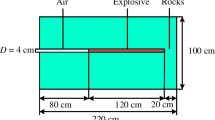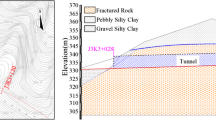Abstract
The discrete element method (DEM) can analyze the large deformation and large displacement of rock mass effectively, and it is widely used in underground engineering, slope engineering and other fields. However, due to the low accuracy of rock mass structural surface information acquisition, the application of discrete element method in the analysis of jointed rock mass stability is still deviated. In this paper, combined with the advantages of the tunnel seismic prediction (TSP) in obtaining discontinuous geological interface information and the discrete element method in the calculation and analysis of jointed rock mass stability, this paper proposes an advanced analysis method for jointed rock mass stability based on TSP and DEM. Compared to the traditional methods, the analysis results of the jointed rock mass stability are more reliable. Firstly, relying on the advanced detection system — Tunnel Seismic Prediction 203Plus, the unstructured rock mass structure information of the tunnel is obtained, and the spatial attitude of the discontinuous geological interface is further determined. Secondly, based on the Fish programming language, the non-continuous geological interface information can be expressed in the discrete unit software — 3D Distinct Element Code (3DEC). In this way, the excavation calculation model of the tunnels in jointed rock mass can be constructed. Finally, based on the DEM, the excavation of the tunnels in jointed rock mass can be simulated, analyze the stability of surrounding rock during the tunnel excavation process, and realize the stability analysis of surrounding rock stability of jointed rock mass. Based on the Huangjiazhuang Tunnel Project, this paper uses the above method to carry out on-site application. The results show that the location of the dangerous block is predicted to be consistent with the actual exposure of the tunnel surrounding rock based on TSP and DEM, which verify the accuracy and feasibility of this method, and the research results have practical guiding significance for the safe construction of the tunnels in jointed rock mass.
Similar content being viewed by others
References
Bu L, Li S, Shi S, Xie X, Li L, Zhou Z, Wen Z (2018) A new advance classification method for surrounding rock in tunnels based on the set-pair analysis and tunnel seismic prediction system. Geotechnical and Geological Engineering 36(4):2403–2413, DOI: https://doi.org/10.1007/s10706-018-0471-5
Cacciari P, Marcos M (2017) Modeling a shallow rock tunnel using terrestrial laser scanning and discrete fracture networks. Rock Mechanics and Rock Engineering 50(5):1217–1242, DOI: https://doi.org/10.1007/s00603-017-1166-6
Cao S, Du C, Mu C, Lei Y (2015) UDEC-based modelling of mining surface movement due to transforming from block caving to sublevel filling and its law verification. Rock and Soil Mechanics 36(6):1737–1743+1751, DOI: https://doi.org/10.16285/j.rsm.2015.06.027 (in Chinese)
Cui Z, Sheng Q, Leng X (2016) Control effect of a large geological discontinuity on the seismic response and stability of underground rock caverns: A case study of the Baihetan #1 surge chamber. Rock Mechanics & Rock Engineering 49(6):2099–2114, DOI: https://doi.org/10.1007/s00603-015-0908-6
Cundall P (1971) A computer model for simulating progressive large scale movements in blocky rock systems. Proceedings of the Symposium of the International Society of Rock Mechanics
Diederichs M, Kaiser P, Eberhardt E (2004) Damage initiation and propagation in hard rock during tunnelling and the influence of near-face stress rotation. International Journal of Rock Mechanics & Mining Sciences 41(5):785–812, DOI: https://doi.org/10.1016/j.ijrmms.2004.02.003
Donovan J, Karfakis M (2004) Design of backfilled thin-seam coal pillars using earth pressure theory. Geotechnical and Geological Engineering 22(4):627–642, DOI: https://doi.org/10.1023/b:gege.0000047047.65476.c6
Fu D, Zhou L, Xiao G, Wang F (2018) Analysis of influence of filter frequency band on tunnel seismic prediction results. Rock and Soil Mechanics 39(S2):315–325, DOI: https://doi.org/10.16285/j.rsm.2018.0803 (in Chinese)
He P, Li SC, Li L, Xu Z, Shi S, Chen Y (2017) Discontinuous deformation of surrounding rock for small-space tunnel with super-large section in jointed rock mass. Chinese Journal of Geotechnical Engineering 40(10):1889–1896
Hu H, Yu G (2011) Application of TSP203 plus advanced geological prediction system in Gaozhuding tunnel fault. Journal of Railway Engineering Society 28(5):1–4+16
Hudson J, Feng X (2007) Updated flowcharts for rock mechanics modelling and rock engineering design. International Journal of Rock Mechanics & Mining Sciences 44(2):174–195, DOI: https://doi.org/10.1016/j.ijrmms.2006.06.001
Itasca Consulting Group, Inc (1999) Three dimensional distinct element code. Itasca Consulting Group, Inc., Minneapolis, MN, USA
Jiang D, Li G, Ma W, Zhang M, Wang T (2018) Mechanism of non-harmonious roadway floor heave in complex jointed rock mass and control measures. Journal of Mining and Safety Engineering 35(2): 238–244, DOI: https://doi.org/10.13545/j.cnki.jmse.2018.02.002 (in Chinese)
Kulatilake P, Ucpirti H, Wang S, Radberg G, Stephansson O (1992) Use of the distinct element method to perform stress analysis in rock with non-persistent joints and to study the effect of joint geometry parameters on the strength and deformability of rock masses. Rock Mechanics and Rock Engineering 25(4):253–274, DOI: https://doi.org/10.1007/BF01041807
Li L, Hu J, Li S, Qin C, Liu H, Chen D, Wang J (2021) Development of a novel triaxial rock testing method based on biaxial test apparatus and its application. Rock Mechanics and Rock Engineering, DOI: https://doi.org/10.1007/s00603-020-02329-3
Li S, Liu H, Li L, Shi S, Hu J, Sun S (2018) Research status and development trend of tunnel dangerous stone identification and prevention. China Journal of Highway and Transport 31(10):5–22
Liu H (2017) Evolution mechanism, prediction method and engineering application of tunnel dangerous rock disaster. PhD Thesis, Shandong University, Jinan, China
Shi S, Li S, Li L, Zhou Z, Wang J (2014) Advance optimized classification and application of surrounding rock based on fuzzy analytic hierarchy process and tunnel seismic prediction. Automation in Construction 37:217–222, DOI: https://doi.org/10.1016/j.autcon.2013.08.019
Song S, Li S, Li L, Shi S, Zhou Z, Liu Z, Shang C, Sun H (2019) Model test study on vibration blasting of large cross-section tunnel with small clearance in horizontal stratified surrounding rock. Tunnelling and Underground Space Technology 92, DOI: https://doi.org/10.1016/j.tust.2019.103013
Wu Q, Tang H, Wang L, Lei G, Fang W (2014) Study on size effect and spatial anisotropy of mechanical parameters of complex jointed rock mass based on three-dimensional discrete element simulation test. Chinese Journal of Rock Mechanics and Engineering 33(12):2419–2432, DOI: https://doi.org/10.13722/j.cnki.jrme.2014.12.007 (in Chinese)
Xiang X, Wang Y, Meng G, Jiang Y, Lu W (2012) Study of stability and support measures of arched roof of large-span underground caverns. Chinese Journal of Rock Mechanics and Engineering 33(22):3643–3649
Xu Z, Li S, Zhang Q, Liu B, Zhang W, Ge Y (2008) Study on seismic wave reflection characteristics of TSP advanced geological prediction. Chinese Journal of Underground Space and Engineering 4:640–644+716
Xue Y, Li S, Zhang Q, Li S, Liu B (2007) Application of TSP203 advanced prediction system to detect karst tunnels. Chinese Journal of Underground Space and Engineering 3(7):1187–1191, DOI: https://doi.org/10.3969/j.issn.1673-0836.2007.z1.001 (in Chinese)
Zhou X, Xu W, Yu X, Cui Y (2007) Review of distinct element method researching progress and application. Rock and Soil Mechanics 28(S1):408–416
Zhu Y, Zhu H, Shi A, Meng G (2011) Complicated block stability analysis of Baihetan hydropower station based on distinct element method. Chinese Journal of Rock Mechanics and Engineering 30(10):2068–2075
Acknowledgments
This work was supported by the National Science Fund for Excellent Young Scholars (51722904), National Natural Science Foundation of China (51679131), Shandong Transportation Science and Technology Plan (2019B47_1).
Author information
Authors and Affiliations
Corresponding author
Rights and permissions
About this article
Cite this article
Fan, H., Li, L., Liu, H. et al. Advanced Stability Analysis of the Tunnels in Jointed Rock Mass Based on TSP and DEM. KSCE J Civ Eng 25, 1491–1503 (2021). https://doi.org/10.1007/s12205-021-0170-2
Received:
Revised:
Accepted:
Published:
Issue Date:
DOI: https://doi.org/10.1007/s12205-021-0170-2




